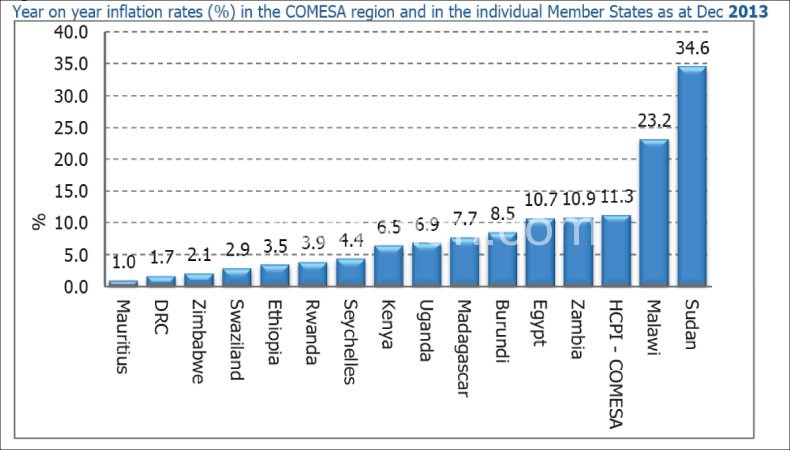December inflation twice Comesa average

Malawi’s Common Market for Eastern and Southern Africa (Comesa) harmonised inflation rate for December 2013 stood at 23.2 percent, about two times the region’s rate.
The trading bloc’s December Harmonised Consumer Price Index (HCPI) monthly news released in January 2014 indicates that Malawi’s inflation was the second highest in the region after Sudan’s 34.6 percent.
According to Comesa, the year-on-year inflation rate in the region declined to 11.3 percent in the month from 12.5 percent registered in November 2013.
This means that the prices of goods and services as measured by the Comesa CPI decreased by an average 0.7 percentage points between December and November 2013. Alternatively an item that cost 100 cents in November decreased to 99.3 cents in December 2013.
Comesa further notes that the region’s annual average inflation rate stood at 9.7 percent in 2013 which means that prices of goods and services as increased by an average of 9.7 percent between 2012 and 2013.
But Malawi’s inflation based on the HCPI averaged 29.2 percent in 2013 the highest in the region followed by Sudan at 30.9 percent.
That is compared to 2012 goods and services in Malawi rose by close to 30 percent.
Malawi’s inflation as provided by the National Statistics office (NSO) turned the corner in September at 21.7 after peaking in February at 37.9 percent. In December Malawi’s inflation rose to 23.5 percent.
Recently Nico Asset Managers, a local investment advisory firm noted that higher inflation will lead to higher prices and lower disposable incomes for both businesses and households.
In 2014, authorities expect higher inflation rates in Malawi with the International Monetary Fund (IMF) Extended Credit Facility (ECF) targets being raised from 5.8 percent to 9.7 percent while the annual average has been increased from 8.1 percent to 15.1 percent.
The fund notes that the revised monetary programme is based on Reserve Bank of Malawi (RBM) tightening monetary policy over the next few months and more aggressively sterilising foreign exchange inflows when the tobacco season starts.
The central bank has been implementing a tight monetary policy to reign in the high inflation.
But Chancellor College professor of economics Ben Kaluwa earlier cautioned the central bank for being desperate to control money supply and rein.
He noted that the policy was wrong bearing in mind that the country’s inflation is predominantly food and urged authorities to ensure increased food productions which would effectively reduce prices.
Malawi inflation, which is based on a Consumer Price Index (CPI), is made up of 50.2 percent food and non-alcoholics.





